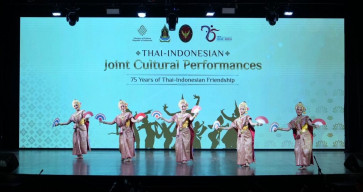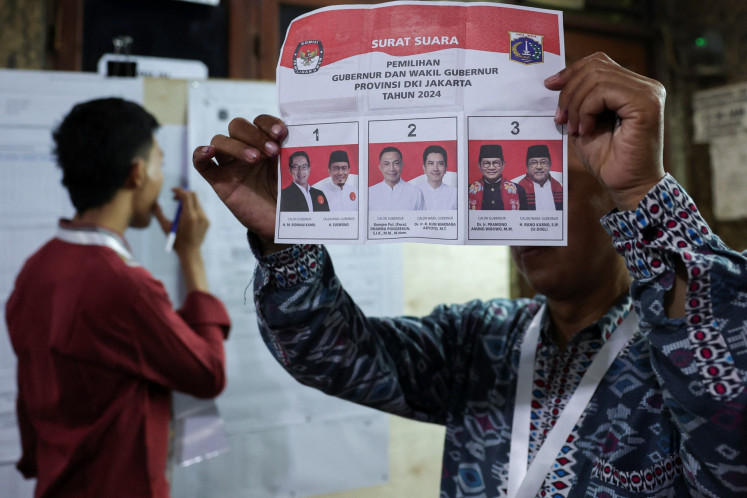Popular Reads
Top Results
Can't find what you're looking for?
View all search resultsPopular Reads
Top Results
Can't find what you're looking for?
View all search resultsChinese gadgets cheap but innovative
With a huge population and increasing demand for products related to IT, Indonesia is regarded as one of Asia's largest markets for mobile phones and laptops
Change text size
Gift Premium Articles
to Anyone
W
ith a huge population and increasing demand for products related to IT, Indonesia is regarded as one of Asia's largest markets for mobile phones and laptops.
So far, the lucrative domestic market is, however, dependent on imported products. Since Indonesia does not have any manufacturing facilities or supporting industries, such those for the highly functional IC and other core electronic components, imported laptops and mobile phones have been flooding the country. In recent years, local consumers of cellular phones and laptops have had more alternatives to choose from following the emergence of Chinese IT products.
The Indonesia Computer Dealers Association (Apkomindo) has predicted that laptop sales will rise by 40 percent this year from the 2.2 million units recorded in 2009. Domestic demand for laptops, according to the association, is predicted to grow by 30 to 40 percent annually.
Consumers in Indonesia are familiar with leading laptop brands like Acer, Compaq, Lenovo, Sony, Toshiba and other popular names. A number of "new" brands have also entered the market, like A-note, Axioo, Byon, Prolink, SPC and Zyrex. Some of the products are imported and some are locally assembled and branded with components imported from China.
Data recently unveiled by the Trade Ministry, however, show that the value of imported laptops during January-November 2009 reached US$461 million, up by 30.4 percent compared to figure in the full 12-month period in 2008. Out of the figure in 2009, laptops from China accounted for 90.4 percent with a value of $416.7 million. Other imports were from Singapore (3.75 percent), Malaysia (2.62 percent), Japan (2.32 percent), Hong Kong (0.24 percent) and other countries (0.67 percent).
The Indonesian market for mobile phones made in China is predicted to rise after the introduction of the China-ASEAN Free Trade Area early this year, and more importers are making Indonesia a country of destination for their products.
Compared to laptops, mobile phones are more "visible" in several markets. Like laptops, the Chinese mobile phones sold in Indonesia are generally local brands. In some cases, businesspeople in Indonesia ordered certain amounts of products or types from manufacturers in China who then produce gadgets with the brands requested by the buyers.
Among dozens of other "newcomers" in the mobile phone market in Indonesia are deZZo, Diga, D-One, G-Star, Gvon, HT, K-Touch, Mito, Maxtron, Micxon, Nexian, SPC, Tiphone, Titans, Tocall and so on. There are also leading brands such as Huawei and ZTE.
Sometimes in the capital and other cities in Indonesia people can also find mobile phones made in China bearing names with similar spellings to famous products like LPhone, Nckia, Sansung or Souy Ericssom.
Lower prices with full features and stylish are what most medium-end level mobile phone consumers in Indonesia want at the moment. Most of them can find what they want in such gadgets made in China.
Imas, a shopkeeper at Roxy HP, one of most crowded shops at Roxy Mas, the busiest mobile phone shopping center in Jakarta, said that people were looking for mobile phones costing around Rp 600,000 that have various features, especially web and messenger applications.
"A GSM or CDMA phone from China is in very high demand at the moment as it generally costs 30 to 50 percent less than famous brands in the same category. But it is more competitive as the gadget has one-gig memory and with Facebook, Twitter and YahooMessenger applications," she said, adding that users would need to download such applications in utilizing the similar type of popular brands.
She said that most of the Chinese brands also had great looks just like the stylish, leading brands. Imas' shop can sell up to 20 new Chinese cell phones per day, much higher than Nokia, Samsung or LG sales, which counted fewer than 11 altogether daily.
"In terms of quality, I think Chinese products are pretty good. Besides, in electronic goods, we can't predict the lifespan as it depends on how we use and maintain the products," she said.
She added that some people bought Chinese products as a second or third terminal just for fun as they already had iPhones and BlackBerries.
The Chinese gadgets often come with innovative elements either rare or nonexistent in famous brands. For example, there are "the clones" of iPhone and BlackBerry and the popular QWERTY phones, which come with dual-on GSM SIM, analog TV tuner, FM radio, music player, VGA camera, JAVA, GPRS, WAP, Bluetooth, Opera Mini browser and Facebook and eBuddy applications. In Jakarta, they cost about Rp 800,000. Other brands made in China also feature TV tuner, dual cameras, Wi-Fi and video player with very competitive prices, or less than Rp 1 million.
The domination of Chinese terminals has somehow affected the market share of popular brands.
Ellianah Setiady, a director of PT Trikomsel Multimedia, the largest multimedia and telecommunications tools retailer and distributor in Indonesia, said that distribution and after sales service were very important in winning the competition.
"There's been an impact *of Chinese mobile phones flooding Indonesia*. But we can manage it with our great distribution system, especially for Nokia. Established after sales service is also important to maintain market share in the country," she said.
To be frank, according to Eko Nilam, chairman of the Indonesian Cellular Phone Importers (PISI), almost all mobile phones sold in Indonesia are made in China, as the leading brands operate facilities in China and a few in other Asian countries, but not in Indonesia.
"The mobile phone sector is lucrative here. Sales totaled 35 million units in 2009 and we expect 40 million units to be sold this year," he said, adding that the annual growth rate would range around 20 percent.










